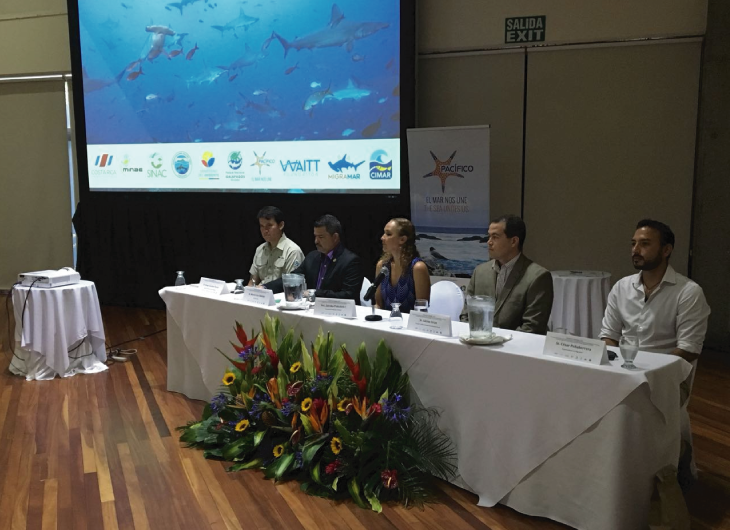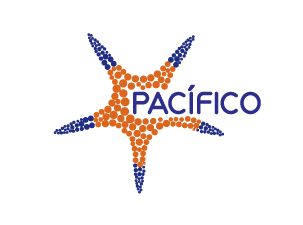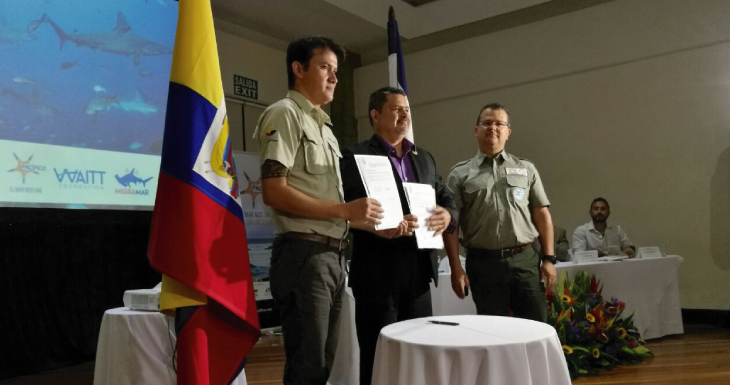- Agreement will set up channels and links to design, develop and execute actions to strengthen management of their respective protected areas.
- PACÍFICO Foundation successfully completes an expedition in that cross-border area and is working with scientists to analyze all data collected and make decisions.
27 April 2018. Costa Rica and Ecuador signed a framework cooperation agreement for the conservation of aquatic and bird species that will strengthen ecosystem conservation, control and protection in the Galapagos Islands (Ecuador) and Cocos Island (Costa Rica) National Parks. The signing took place during an event ending the first Galapagos-Cocos expedition carried out by a group of scientists in this cross-border area of the Pacific Ocean.
Mario Coto, executive director of the Costa Rican National System of Conservation Areas (SINAC, Spanish acronym), said, “The framework cooperation agreement between the Galapagos National Park of Ecuador and the National System of Conservation Areas of Costa Rica, as the governing body of Cocos Island National Park, will enable us to join forces to establish channels and links of mutual association to design, develop and execute joint actions and projects on various topics, as well as strengthen the administration and management of their respective protected areas.”
According to the signed document, the authorities will work on aspects such as:
- Research to generate knowledge about marine and terrestrial biodiversity of the marine protected areas
- Marine-coastal monitoring
- Management and eradication of exotic species
- Planning and evaluation of protected wildlife areas
- Climate change
- Prevention, control and protection
- Capacity building
- Acquiring resources for execution of projects
- Digital information platforms
- Ecosystem restoration
- Exchange of experiences
- Joint prevention strategies for human security
- Sustainable tourism
The implementation of the agreement, signed Friday, April 27, in Costa Rica, will be led by the executive director of SINAC, Mario Coto Hidalgo, and the director of the Galapagos National Park, Jorge Carrión, whose institutions will coordinate and plan decision making for execution of the agreement.
Expedition surpasses expectations
“All expectations were broken,” reported the scientists who participated in the expedition.
“Several species of sharks and sea turtles using the Cocos range as a migratory pathway between these marine protected areas were identified. Visual evidence had not been obtained or published until now, fulfilling one of our objectives: to determine and demonstrate the ecological importance of the area for species such as sharks and other large pelagics,[1]” said Jorge Carrión, director of Galapagos National Park, Ecuador.
Baited remote underwater video systems (BRUVS) were installed on eight underwater mountains (seamounts), at depths of 160 meters to 900 meters all along the pathway to obtain information and quantify the distribution, abundance and diversity of species. Also analyzed was the effect of factors such as temperature, depth and distance of the underwater mountains on the distribution and abundance of the marine species found.
The cameras registered 438.73 hours of recording between the Galapagos and Cocos Island; species such as bottlenose dolphin, sailfish, pilot fish, striped marlin, whales, green turtles, Galapagos shark, hammerhead shark, thresher shark and silky shark were identified, among others.
“PACÍFICO is collaborating with the scientific team that participated in the expedition to analyze all the data collected as well as the video sequences, GPS information and deployments of the BRUVS and the route during drift time at sea, depth, temperature and other relevant information,” said Zdenka Piskulich of the PACÍFICO Foundation, which promoted the expedition.

She added that PACÍFICO, together with MigraMar[2] and the Center for Research in Marine Sciences and Limnology (CIMAR, Spanish acronym)[3] of the University of Costa Rica, are preparing documents on the scientific work as well as details about the experience to be published in relevant scientific journals.
The Galapagos-Cocos expedition was developed by the PACÍFICO Foundation with the Galapagos National Park Office and SINAC-Cocos Island National Park, with financing by the Waitt Foundation, the Shark Conservation Fund and the Helmsley Charitable Trust, and the important participation of MigraMar and CIMAR of the University of Costa Rica.
Galapagos-Cocos expedition was a success because:
- It demonstrated that BRUVS can be used on the high seas to obtain key relevant scientific information.
- The videos show the use of the marine corridor by iconic, highly migratory species.
- It strengthened public-private partnerships for carrying out joint initiatives.
- It emphasized the importance of cross-border marine conservation and collaboration.
- It highlighted the need for both countries as well as managers of marine protected areas to work together in marine corridors.
[1] That live in areas distant from the coast.
[2] Nonprofit organization that carries out scientific research needed to safeguard healthy populations of migratory marine species in the Tropical Eastern Pacific.
[3] Centro de Investigación en Ciencias del Mar y Limnología

